The general purpose of the project was to elaborate a strategy of nanotechnology development up to 2020 based on the desired priority directions of the Polish Podlaskie province development oriented towards the application of nanotechnologies and the identification of the key nanotechnology research trajectories.
Nanotechnology to Boost Disadvated Region
The project Technological foresight NT FOR Podlaskie 2020. Regional strategy of nanotechnology development was granted the financial support from the EU Operational Program „Innovative Economy 2007-2013” (Priority 1: „Research and development of new technologies”, Measure 1.1.: „Support for scientific research for the building of knowledge based economy”, Sub-measure 1.1.1: „Research projects with the use of foresight method”.)
The project is an attempt of breakthrough technologies promotion in situation when the development of the traditional sectors does not contribute to regional growth. It is located in one of the least economically developed regions of Poland (and of the European Union) with a low level of population’s economic welfare, little business competitiveness and low innovation intensity in the spheres of technology, processes and products. The project is based on the feed forward logic which assumes that the future changes of the environment will be effectively forestalled owing to the project results. This should allow the region to chart the development trajectory which doesn’t imitate others but heads in the direction where the leaders will be in the future. The assumed goals of the programme are:
- elaborate a strategy of nanotechnology development in Podlaskie province till 2020
- identify and mapp critical nanotechnologies up to 2020
- identify the most important factors influencing the development of nanotechnologies
- put forward scenarios of nanotechnology development
- stimulate the process of regional vision building between the key stakeholders.
Nanotech Research Defined by Six Panels
Six panels defined the research priorities for the project:
- Nanotechnologies in Podlaskie economy (RF1)
- Nanotechnology research for Podlaskie developement (RF2)
- Key factors of nanotechnology development (RF3)
In addition to the three content-oriented panels another three focusses on methodologies: STEEPVL and SWOT panel (SSP), Technology mapping and Key technologies panel (TMKTP), Scenarios and Roadmapping panel (SRP) (figure 1).
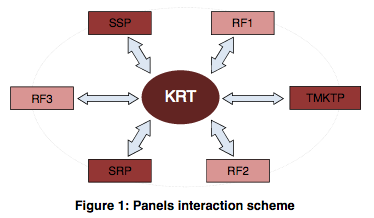
The results of the six panels are integrated by the Key Research Team (KRT) which is also a platform of interaction and knowledge transfer between the panels.
From STEEPVL Analysis to Strategy
The methodology of the project is based on the intuitive logics school of scenario construction and comprises the following research methods and techniques: STEEPVL analysis, SWOT analysis, technology maping, key technologies, scenario method, roadmapping (figure 2). The main research methods are supported by brainstorming, moderated discussion and bibliometrics.
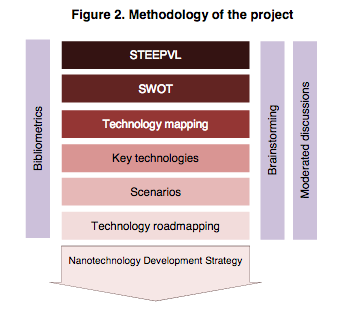
The selection of methods and techniques was conditioned by the aim of the project, planned funds, research duration and availability of data – both quantitative and qualitative.
One of the innovative elements of the project is the implementation of the concept of triangulation to experts’ recruitment in the aspect of researcher triangulation, data triangulation and theoretical triangulation.
Researcher triangulation was manifested in the project by the involvement of experts representing varied professional background, sex and age. Special attention was paid to the recruitment of women and young people (under 35) (min. 30%).
Data triangulation was achieved by involving experts representing different institutions as well as by drawing information about the factors shaping nanotechnology development via experts’ opinions verified by the existing published works (reports, books, publications, Internet sources on nanotechnologies).
Theoretical triangulation consisted in the involvement of experts representing different research fields, but still salient to the nanotechnology development in Podlaskie province.
Other innovative element of the project was the application of the two-dimensional assessment of STEEPVL factors taking into account (1) the influence and importance of factors and (2) the application of factor analysis in order to reduce the number of considered factors that shape the nanotechnology development.
Great attention in the project was paid to the development of technology mapping methodology, to the identification and the assessment of wild cards methodology and to roadmapping methodology.
Scenarios of Nanotechnology Development in Podlaskie Province
As a result of the conducted sequence of procedures four scenarios of nanotechnology development in Podlaskie province were developed. They were constructed along two axes, one of which related to the level of R&D in the region and the other to the level of collaboration among the actors from business, science and administration spheres (fig. 3).
Basic characteristics of the produced scenarios are presented in table 1. Further in the process, each scenario was enriched with a detailed description of the remaining 19 STEEPVL factors. Short descriptive visions were also written in each of the four cases.
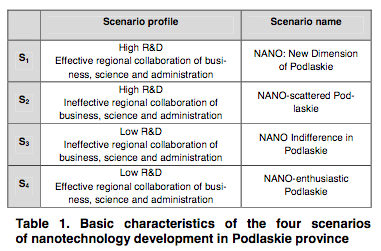
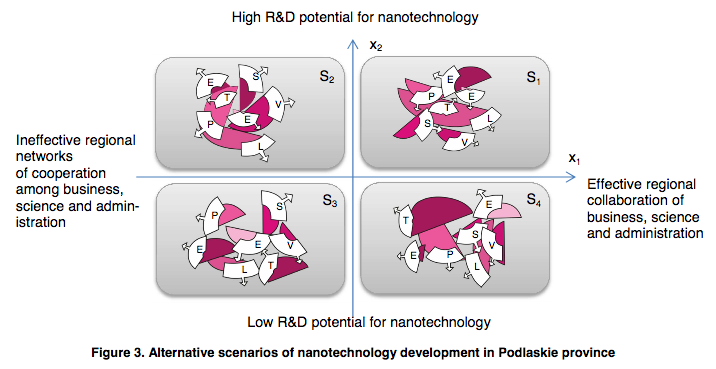
- Megatrends
Scenarios formulation was preceded by a detailed characteristics of megatrends influencing the nanotechnology development. Following megatrends were identified:
- technological progress,
- ageing population,
- increasing importance of alternative energy sources,
- intensified activity of the states in the realm of security,
- new patterns of social inequality,
- shaping of the new economy,
All megatrends were further divided into branching trends.
- Priority technology groups
Additionally, seven priority technology groups for the Podlaskie region were identified by the experts:
- nanomaterials and nanosurfaces in medical equipment (T20),
- composite materials for dentist fillings (T17),
- powder technologies in plastic, paint and varnish production (T31),
- surface nanotechnologies in biomedicine (T21),
- nanotechnology for cutting instruments and wood processing (T3),
- nanotechnology for specialised textiles (T24),
- nano-structuring of metals (T38).
The leading project experts attempted to embed the priority nanotechnologies into four scenarios by assessing the chances of each technology’s development in the context of a particular scenario. The results of that exercise are presented in fig. 4.
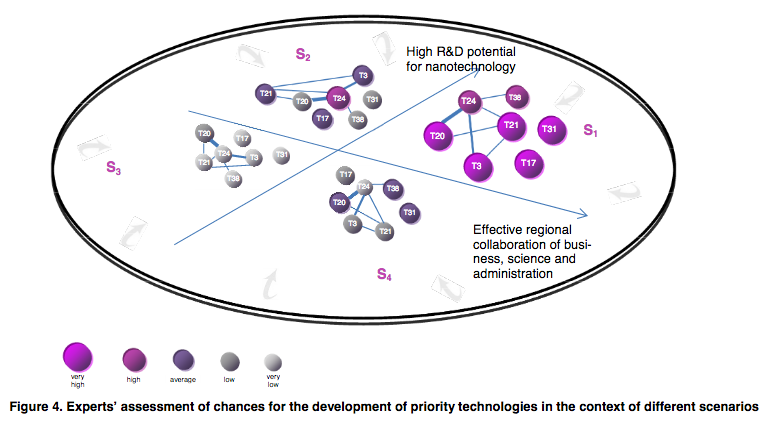
According to experts’ opinions in conditions of high R&D potential for nanotechnology and effective regional collaboration of business, science and administration, very high chances of development have five out of seven technologies, namely: powder technologies in plastic, paint and varnish production (T31), composite materials for dentist fillings (T17), surface nanotechnologies in biomedicine (T21), nanotechnology for cutting instruments and wood processing (T3), nanomaterials and nanosurfaces in medical equipment (T20). In S2 scenario high chances of development have only nanotechnologies for specialised textiles (T24). The situation in S2 and S3 scenarios changes fundamentally as there are no nanotechnologies of high chances of development.
For each identified key technology a roadmap of its development was elaborated comprising layers such as: resources, R&D, technology and applications.
Increasing R&D and Strengthening the Network
| Authors: | Anna Kononiuk a.kononiuk@pb.edu.pl
Lukasz Nazarko l.nazarko@pb.edu.pl Joanicjusz Nazarko j.nazarko@pb.edu.pl Joanna Ejdys j.ejdys@pb.edu.pl Katarzyna Halicka k.halicka@pb.edu.pl Urszula Glinska u.glinska@pb.edu.pl Alicja Gudanowska a.gudanowska@pb.edu.pl |
|||||||
| Sponsors: | European Regional Development Fund, Operational Program „Innovative Economy 2007-2013”
Ministry of Science and Higher Education of the Polish Republic |
|||||||
| Type: | regional/technological foresight exercise | |||||||
| Organizer: | Bialystok University of Technology
Joanna Ejdys j.ejdys@pb.edu.pl Joanicjusz Nazarko j.nazarko@pb.edu.pl |
|||||||
| Duration: | Apr 2009-Jun 2013 | Budget: | 588,256 € | Time Horizon: | 2020 | Date of Brief: | Aug. 2012 | |
Download: EFP Brief No. 235_Nanotechnology for Podlaskie 2020.
Sources and References
Feasibility study of Technology foresight „NT FOR Podlaskie 2020”. Regional strategy of nanotechnology developement [Studium wykonalności projektu Foresight technologiczny „NT FOR Podlaskie 2020”. Regionalna strategia rozwoju nanotechnologii], Białystok 2008.